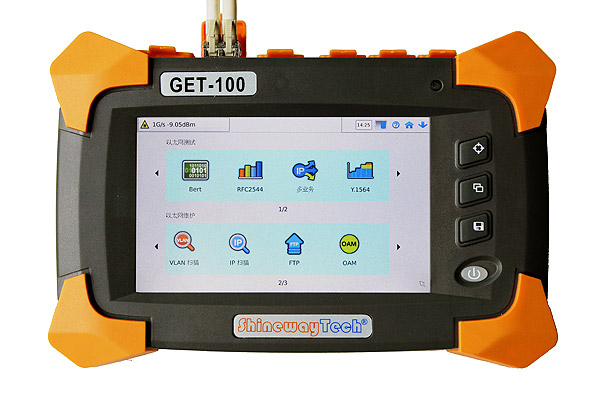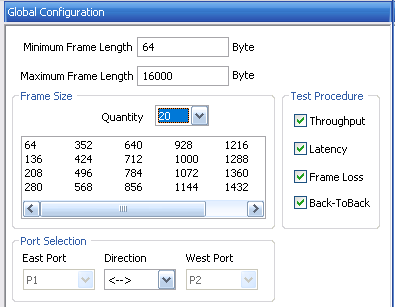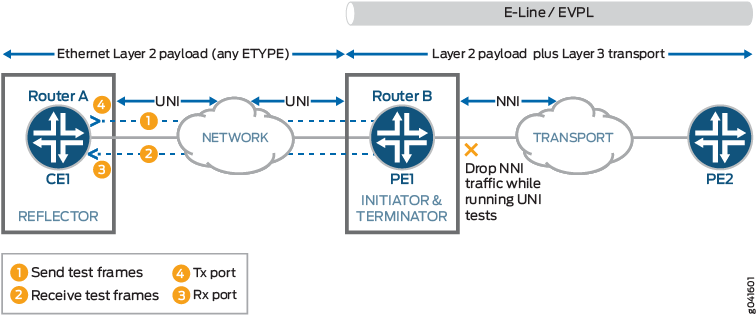

- #Rfc 2544 ethernet testing pdf
- #Rfc 2544 ethernet testing full
- #Rfc 2544 ethernet testing software
- #Rfc 2544 ethernet testing trial
System reset: Measures the speed at which a DUT recovers from a hardware or software reset. With protocols like voice over Internet protocol (VoIP), a variable or long latency can cause degradation in voice quality. It is the time taken by a bit to go through the network and back. Latency is the time interval that begins when the last bit of the input frame reaches the input port and ends when the first bit of the output frame is seen on the output port. Latency: Measures the round-trip time taken by a test frame to travel through a network device or across the network and back to the test port. This measurement can be used for reporting the performance of a network device in an overloaded state, as it can be a useful indication of how a device would perform under pathological network conditions such as broadcast storms. Frame loss: Defines the percentage of frames that should have been forwarded by a network device under steady state (constant) loads that were not forwarded due to lack of resources. This measurement is a good indication of the buffering capacity of a DUT. Back-to-back or burstability: Measures the longest burst of frames at maximum throughput or minimum legal separation between frames that the device or network under test will handle without any loss of frames. This measurement translates into the available bandwidth of the Ethernet virtual connection. Throughput: Measures the maximum rate at which none of the offered frames are dropped by the device/system under test (DUT/SUT). RFC 2544 provides engineers and network technicians with a common language and results format. This request for Comments (RFC) was created in 1999 as a methodology to benchmark network devices such as hubs, switches and routers as well as to provide accurate and comparable values for comparison and benchmarking. The Internet Engineering Task Force RFC 2544 is a benchmarking methodology for network interconnect devices. This recommendation does not define Ethernet network architectures or services, but rather defines a methodology to test Ethernet-based services at the service activation stage. The test methodology applies to point-to-point and point-to-multipoint connectivity in the Ethernet layer and to the network portions that provide, or contribute to, the provisioning of such services. ITU-T Y.1564 defines an out-of-service test methodology to assess the proper configuration and performance of an Ethernet service prior to customer notification and delivery. ITU-T Y.1564 is designed to serve as a network service level agreement (SLA) validation tool, ensuring that a service meets its guaranteed performance settings in a controlled test time, to ensure that all services carried by the network meet their SLA objectives at their maximum committed rate, and to perform medium- and long-term service testing, confirming that network elements can properly carry all services while under stress during a soaking period.  2 Existing test methodologies: RFC 2544. Valkyrie2544Run utility for executing test configurations via CLI. xml formatĪll Xena testers and all port speeds from 10/100/1000M, 10G, 40G, and 100G – Testing between any combinations of port-speeds – Uni-directional or Bi-directional testing – Point-2-Point, Point-2-MultiPoint, MultiPoint-2-Point
2 Existing test methodologies: RFC 2544. Valkyrie2544Run utility for executing test configurations via CLI. xml formatĪll Xena testers and all port speeds from 10/100/1000M, 10G, 40G, and 100G – Testing between any combinations of port-speeds – Uni-directional or Bi-directional testing – Point-2-Point, Point-2-MultiPoint, MultiPoint-2-Point #Rfc 2544 ethernet testing trial
– Per test, per trial and per frame size learning – Forwarding, including throughput and forwarding rates with a 16ns resolution – Ethernet,VLAN, Q-in-Q, MPLS, IPv4 and IPv6 frame support – Latency (FIFO, and LILO) for store-and-forward and cut-through DUTs

Support for both standard and fully user defined test configuration.
 Summary and comprehensive detailed results. Reduce time-to-test through easy configuration and fast execution. Supports both single stream and multi-stream testing. Easy point-to-point, point-to-multipoint, and multipoint-to-point testing.
Summary and comprehensive detailed results. Reduce time-to-test through easy configuration and fast execution. Supports both single stream and multi-stream testing. Easy point-to-point, point-to-multipoint, and multipoint-to-point testing. #Rfc 2544 ethernet testing full
Large port count and full mesh tests, uni-directional or bi-directional testing.Test with jumbo frames and verify low-latency and wire-rate.Perform all RFC 2544 tests over VLANs and IPv4 & IPv6 protocols.
#Rfc 2544 ethernet testing pdf
Finally, the application will create test reports in both PDF and XML format and Linux is supported via the Mono framework. Valkyrie2544 supports both single stream and multi-stream testing, enabling test engineers to emulate many more clients than the physical port count allows. There are extensive configuration options to fine-tune the tests, and you can define the protocol layers supported by the test (Ethernet, Customer and Service VLANs, IP and UDP) precisely the way you want them. Valkyrie2544 supports different network topologies and traffic flow directions on both Layer 2 and Layer 3, as well as both IPv4 and IPv6. Valkyrie2544 offers full support for the 4 test-types specified in RFC2544, and also lets you partially enable one or more test types.
Automotive Ethernet Transceivers & Converters.








 0 kommentar(er)
0 kommentar(er)
